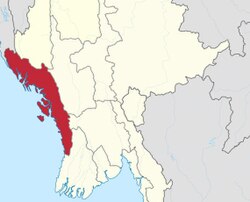
Back Аракан Byelorussian আরাকান Bengali/Bangla آراکان Persian Arakan Galician आरकान Hindi اراکان PNB Arracão Portuguese அரகான் Tamil
Arakan | |
|---|---|
 Arakan lies on the west coast of Burma facing the Bay of Bengal | |
| Status | Waithali Kingdom (8th century-10th century) Lemro Period (11th century) Vassal state of Bengal (15th century) Mrauk U Kingdom (15th century-18th century) Part of the Third Burmese Empire (18th century) Division of British Burma (19th century) Province of Myanmar (1948–present) |
| Capital | Dhanyawadi Waithali Pyinsa Parein Nareinzara Toungoo Launggyet (1251–1429 Mrauk-U (1430–1785) Sittwe (19th century-present) |
| Common languages | Arakanese, Burmese, Rohingya, Bengali |
| Religion | Buddhism, Islam, Hinduism |
Arakan (/ˈærəkæn/ or /ˈɑːrəkɑːn/[1]) is the historical geographical name of Rakhine State, Myanmar (formerly Burma). The region was called Arakan for centuries until the Burmese military junta changed its name in 1989. The people of the region were known as Arakanese.[2][3][4]
Arakan's first states can be traced to the 4th century. Arakan was one of the first Indianized kingdoms in Southeast Asia. It was home to the sacred Mahamuni sculpture of Buddha, which was later transferred to Mandalay by Burmese conquerors in the 18th century. For 356 years between 1428 and 1784, Arakan was ruled by the Kingdom of Mrauk U from the city of Mrauk U. The kingdom was founded as a vassal state of the Bengal Sultanate. It later asserted its independence and adopted the customs of the Bengal Sultanate, including Muslim titles for its kings. Arakan became home to a ethnically and religiously diverse population, with Buddhists making up the majority and Muslims making up the second largest community. It was also home to Hindus and Christians. The Portuguese were active in the region.[3]
Arakan Division was a part of British India and later fell under British rule in Burma. Arakan was a major rice exporter in the world during the 19th and early 20th centuries. During World War II, several Arakan Campaigns were conducted by Allied forces against the Japanese as part of the Burma Campaign. After Burma became independent in 1948, Arakan saw a movement for autonomy. Human rights deteriorated in the country after the 1962 Burmese coup d'état. In 1974, a discriminatory citizenship law was enacted. In 1982, most Arakanese Muslims were stripped of citizenship. A segregated system of citizenship was introduced by Burma's military rulers. Both Arakanese Buddhists and Muslims experienced growing nationalism, including hopes for self-rule. After Burma's controversial citizenship law in 1974, the Buddhists became known as Rakhines and Muslims became known as Rohingya. The region was the site of the Rohingya genocide in 2016 and 2017.
- ^ Columbia Encyclopedia, s.v. "Rakhine State".
- ^ "The long history of the Rohingyas that Myanmar refuses to acknowledge". 29 September 2021.
- ^ a b "Arakanese | Definition, Location, & Ancient Kingdom | Britannica".
- ^ Sheikh, Nur-Mohammad (19 March 2023). "The return of the Arakanese Muslims: Could this be the beginning of a resolution to the Rohingya crisis?". Dhaka Tribune. Archived from the original on 13 Feb 2024. Retrieved 13 Feb 2024.
© MMXXIII Rich X Search. We shall prevail. All rights reserved. Rich X Search